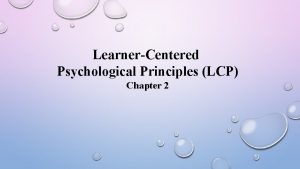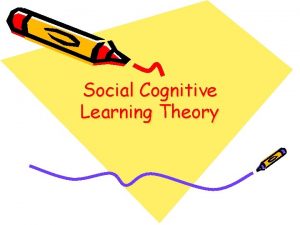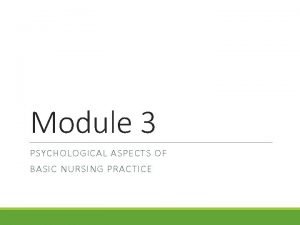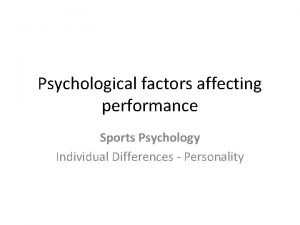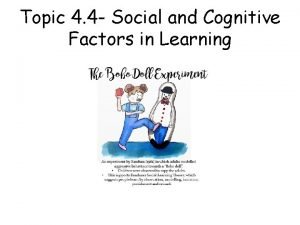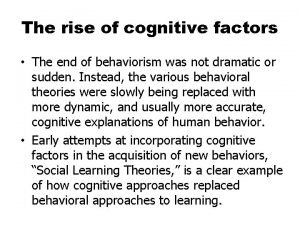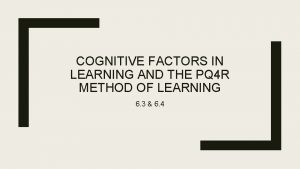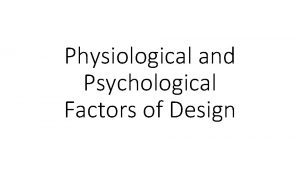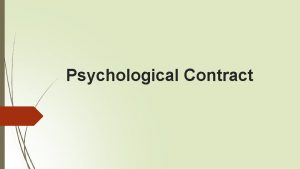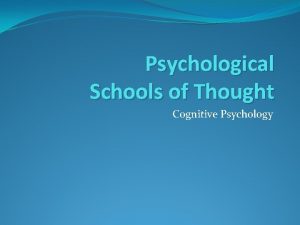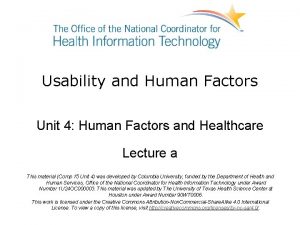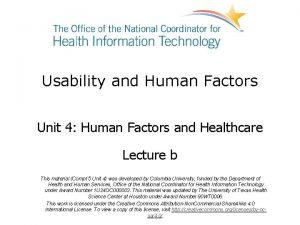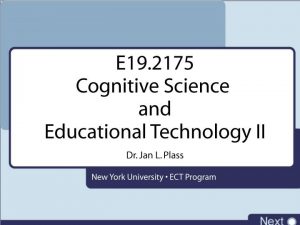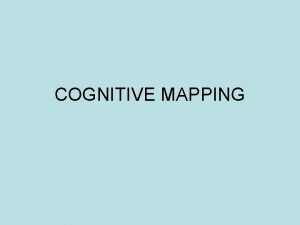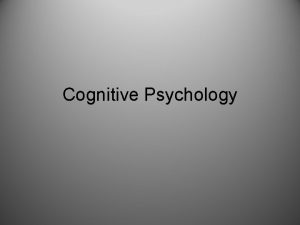Lecture 4 Human Factors Psychological and Cognitive Issues























- Slides: 23

Lecture 4. Human Factors : Psychological and Cognitive Issues 고려대학교 그래픽스 연구실 Virtual Reality

Contents • • • Presence and Reality Human Visual System Human Auditory System Other Perceptual systems Cognitive system

Presence and Reality 1. Tele-presence and Virtual presence 2. AIP cube 3. Model P 4. Measuring reality 5. Philosophical considerations

1. Tele-presence INDEPENDENT VARIABLES DEPENDENT MEASURES Experimental determination of presence, learning efficiency, and performance.

2. AIP Cube • Zeltzer (1992) • A model for describing, categorizing, comparing various VEs, rather than what contitutes the sense of presence. • Three components – autonomy – interaction – presence

autonomy and Interaction • Autonomy – the ability of a computation model to act and react to simulated events and stimuli • 0 : passive, geometric model • 1 : most sophisticated, knowledge based virtual agent • 0. x : physics-based model • Interaction – the degree of access to model parameters at runtime • 0 : "batch" processing - no interaction at runtime • 1 : comprehensive, realtime access to all parameters

autonomy vs. interaction • autonomy - interaction plane – Two axes are complementary (or inter-related). – The level of interaction is (inversely) determined by the degree of autonomy. • degree of freedom problem – Providing direct assess to many parameters is not necessarily productive.

presence – A rough, lumped measure of the number and fidelity of available sensory input and output channels – Measure of the Selective Fidelity – must consider the degree of match between the sensory data and mental model. – may consider sensory substitution (e. g. , auditory output, instead of haptic).

autonomy, interaction, presence (1, 0, 0) Digital Shakespeare (1, 1, 0) Task Level Graphical Simulation Autonomy Conventional Animation Systems ca. 1990 (1, 1, 1) (1, 0, 1) (0, 0, 0) Interaction Presence (0, 0, 1) (0, 1, 0) "Virtual Reality" (0, 1, 1)

Interesting possibilities Autonomy Presence Interaction 0 0 1 1 0 1 0 1 Typical System batch processing of simple models on plotter non-interactive virtual tour animation systems commercial virtual environment high precision simulation "Virtual Theater" MUD(? ) truly a Virtual Reality

3. Model P • Perception – – visual auditory tactlie etc. • Interaction – self – environmental – social • Model – – – geometry kinematics dynamics behavioral cognitive emotional

• Factors that affect the quality of perception – – – inclusiveness surroundedness extensiveness vividness synchronization

4. Measuring reality (1) Psychological and subjective measures (2) Psychophysical measures (3) Physiological measures (4) Performance measures (5) Reflex response

(1) Psychological and subjective measures • procedure i) Scale rating along a uni-directional axis. ii) Compute the psychological distance • Ex. NASA TLX scale – mental load = f (mental demand, physical demand, temporal demand, performance, effort) • Ex. Presence assessment • Ex. factorial studies




• Ex. Discrimination between a real and a virtual worlds P (judged “real” | actually real) P (judged “real” | actually virtual) idea: image quality noise virtual < real virtual = real +

(2) Psycho-physical measures • measures more “local” parameters. • Types of classic problems – – sensory threshold recognition discrimination scale

(3) Physiological measures • classes – – – cardiovascular respiratory nervous sensors blood chemistry

(4) Performance measures • Examples – # of errors – time spent – accuracy • Assumption: presence = f (performance) • But, we may decrease presence intentionally in order to increase performance.

(5) Reflex response • Response to unexpected / threatening stimuli. • Socially-conditioned response • effects of prolonged exposure

5. Philosophical considerations • Theories on reality – – Plato Leibniz Goodman Popper
 Cognitive and non cognitive religious language
Cognitive and non cognitive religious language 01:640:244 lecture notes - lecture 15: plat, idah, farad
01:640:244 lecture notes - lecture 15: plat, idah, farad 14 learner centered psychological principles
14 learner centered psychological principles Cribbr
Cribbr Structure of personality
Structure of personality Module 3 psychological factors
Module 3 psychological factors Psychological factors influencing learning
Psychological factors influencing learning Factors affecting sports performance
Factors affecting sports performance Social factors affecting entrepreneurial growth
Social factors affecting entrepreneurial growth Id psychology example
Id psychology example Psychological factors affecting medical condition
Psychological factors affecting medical condition Physical factors affecting sports performance
Physical factors affecting sports performance Cognitive factors
Cognitive factors Vicarious reinforcement
Vicarious reinforcement Cognitive factors in learning
Cognitive factors in learning Human resources department structure
Human resources department structure Human resource management chapter 1
Human resource management chapter 1 Human resource management lecture chapter 1
Human resource management lecture chapter 1 Biotic and abiotic environment
Biotic and abiotic environment Abiotic vs biotic factors
Abiotic vs biotic factors Abiotic vs biotic factors
Abiotic vs biotic factors Dactors of 8
Dactors of 8 Factors of 7
Factors of 7 Fctors of 8
Fctors of 8


